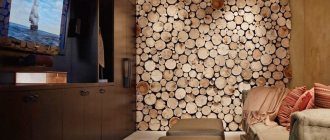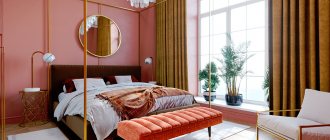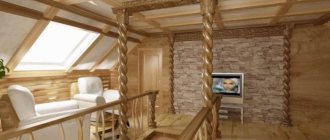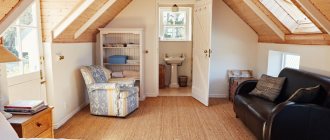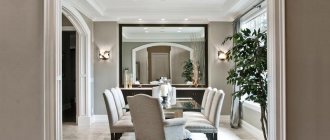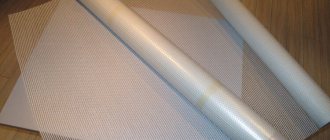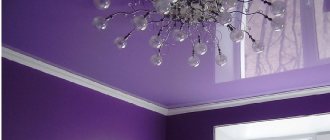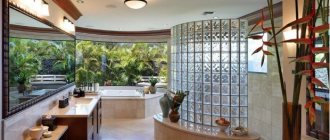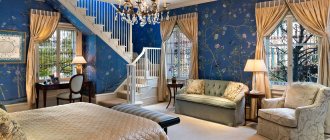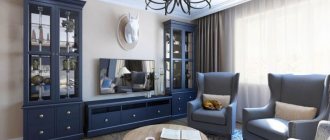You can use decorative stone in the kitchen interior in different ways: make a countertop, decorate the frying area, turning it into a hearth, or even lay out the entire kitchen backsplash. This will give the interior elements of primitiveness and at the same time a lot of grace. An undoubted advantage of decorative stone for the kitchen is its resistance to chemical, thermal and mechanical influences.
Photo: hausmobel.info
4. Decorative stone and lighting
A composition of stone and light can be an excellent interior decoration. The volume of the wall created by the stone, with the right lighting, can give your home the appearance of a small exhibition or a mysterious castle. With the help of light, you can highlight figurines, vases and other home decorations, which will look very advantageous.
Photo: usualhouse.com
Types of decorative stone and interior atmosphere
Modern technologies have made it possible to create analogues of natural stones at low cost. The materials are intended for use as decorative interior finishing. Types of decorative stone:
- Based on cement-concrete mixtures. Depending on the formulation, the composition contains the following components: cement, sand, reinforcing elements, various modifiers and plasticizers. The color palette is determined by coloring pigments. The textural variety depends on the geometry of the forms into which the solution is poured.
- An analogue of cement-concrete mixtures is gypsum. Production is organized according to a similar scheme. The gypsum base is suitable for creating a wide range of decor: brick, natural stone such as savage, sandstone.
- Artificial granite, marble (conglomerates - compounds). Up to 80% contain marble and granite chips obtained from crushed fractions of substandard residues of natural materials. The addition of binding resins, hardeners, and other reagents combines the mass into a durable monolith. In terms of technical characteristics, strength, resistance to mechanical and chemical influences, they are not inferior to natural analogues.
- Porcelain tiles. The mixture from which the tiles are made includes clay, silicates, and magnetic rocks (spars). Coloring pigments allow you to achieve the desired shade. High-temperature firing makes the material durable, resistant to mechanical stress and moisture. Porcelain tiles are an analogue of ceramic tiles with the addition of natural fillers.
- Composite - acrylic stone. Natural mineral fillers are bonded using acrylic resins. Dyes help achieve the desired shade.
Decorative slabs are smooth on the back side. A texture imitating natural material is applied to the outer surface. This shape makes installation easier.
Decorative stone in various stylistic directions
Natural materials, wood, stone, are organically integrated into a diverse style. Decorative artificial tiles make it possible to choose an imitation of natural materials at an affordable price. For example, natural polished marble is much more expensive than porcelain tiles.
Classicism
This category includes styles: baroque, antique, renaissance, neoclassicism and some others. All styles are united by the desire to recreate a richly decorated, solemn interior with a touch of pathos. Marble, polished granite, aventurine with mica inclusions are decorative companions for such interiors. The stone is mainly used to decorate fireplaces, columns, and wall panels. The main thing is to maintain balanced proportions between all the design elements of the room. Use the slab as a floor covering. Decorative marble-effect tiles are used in bathrooms.
Required materials and tools
For high-quality finishing, you need not only high-quality mixtures, but also hand tools. The main ones include spatulas: narrow, wide, straight, trapezoidal, the choice is individual for each individual case. Wide ones are used for the initial application of the solution over the entire area. Use narrow mixtures to level the mixtures in corners, near baseboards, window and door openings. The Venetian trowel is used mainly to create textures. A roller is necessary for leveling soft types of plaster; a sprayer is used to varnish the finish.
Imitation of stone using decorative plaster in a living room in Art Nouveau style
Stone-like plaster over a stove in a country house
Stone-like plaster around the fireplace and arch
Advantages of decorative stone
All types of artificial stone share these qualities:
- availability, relatively inexpensive finishing material;
- ease of installation;
- ease of care;
- resistance to mold, fire;
- durability (manufacturers provide a guarantee of at least 10 years);
- an impressive range of shades and textures.
If the stone is made of gypsum, clay, sand, then add to this list also environmental friendliness and hypoallergenicity.
Color spectrum
There is a large number of color palettes for decorative stonework. Experts advise us to use this or that color depending on the parameters of the room: area, availability of lighting, busy interior. White color is the leader in use in narrow, small corridors, hallways, and bathrooms. It creates a visual increase in the room. Warm shades and grays work well in larger spaces along with wooden materials.
Are there any disadvantages?
After such a solid portion of the obvious advantages of use, any disadvantages will seem completely insignificant. But they exist and, by and large, depend on the characteristics of a particular source material used for design.
- gypsum boards cannot be used in rooms with high levels of humidity - even accidental ingress of moisture can ruin their appearance, and among other things, prolonged exposure to high humidity conditions can cause cracks in the fragments and loss of performance properties;
- in some cases, imitation stone made from concrete or cement looks too conventional and careless, especially when it comes to cheap options - it is advisable to paint the material after finishing and apply a beautiful textured varnish as a finishing layer.
Otherwise, we have before us exactly the material that is convenient to work with, and which, upon installation, demonstrates an invariably pleasing result to the eye.
Features of the use of artificial stone
Thanks to the variety of patterns and colors, decorative stone is a real “must have” for a modern interior.
Minimalism, if you use stone, becomes less bland, a Scandinavian interior becomes more diverse, eco-style and country style become more convincing, and a loft becomes much more comfortable.
Many ethnic styles are difficult to imagine without facing stone. For example, in a Mediterranean house this is a stylization of pebbles or boulders polished by the sea. In Alpine - under mountain debris. The interior is Provence-like, like sun-bleached sandstone. In English - under a strict cherry-colored brick. Artificial, glossy stone has made its way even into high-tech interiors, this “fiefdom” of metal and glass.
Stone is, of course, a unique tool for creating an extraordinary environment, but you shouldn’t go to all lengths. If you decorate the walls with stone tiles from top to bottom, you will get a crypt, a wine cellar, a dungeon... But not a living space.
Cladding with decorative stone solves several problems. Firstly, it is picturesque, elegant and prestigious. Secondly, with the help of stone you can delimit a room into functional zones, make it more voluminous and expressive.
What textures are used in cladding?
Artificial or decorative stone in the interior of an apartment is:
- fashionable;
- exquisite;
- aristocratic;
- extravagantly;
- luxuriously;
- creative.
The most luxurious look is white stone in the interior or covered with enamel. It does not destroy the special atmosphere of the bedroom and perfectly sets off other finishing materials and textiles. It fits perfectly into most styles, regardless of texture. The best solution for a modern bedroom is with imitation white marble on top of a “warm floor” system. The wall cladding behind the head of the bed can be of any texture and not necessarily white.
For design purposes, sometimes a rough texture or contrasting finish is needed. This is used in urban and technological styles - loft, hi-tech or techno. Upholstered furniture of unusual shape requires a corresponding wall or panel. A spectacular backdrop behind a sofa or armchairs, lined with stone decor in a living room or large recreation area, looks very stylish.
Typically, decorative stone is used in hallways and corridors
The fireplace looks elegant against the background of a stone wall
Some people like it when decorating a living space with stone brings a special “wild” atmosphere. The room is more reminiscent of a deserted beach near a cliff, a stone grotto in the mountains, or a cave inhabited by modern city dwellers. In this case, a material with a texture close to the natural surface is used.
Photo wallpaper with a 3D effect, roughly processed wood and vertical landscaping - a wall with living plants - will give a special impression to the “wild nature” corner. Artificial stone in such an interior should imitate natural analogues as much as possible, the masonry should be uneven and a little chaotic. This is exactly what an eco-style room should look like - photo.
Decorating an apartment often involves the use of smooth polished pebbles (river or sea) or colored sea pebbles. An excellent way to use it is to lay out a mosaic pattern, and then paint some fragments. An excellent solution is to lay out pebbles on a kitchen splashback or a decorative panel in a living room.
Finishing the walls with decorative stone would be the right decision.
The wall decoration in the living room is made of decorative gray stone
Decorative stone in the living room will look chic
The use of rough textures has no restrictions for people with imagination and a creative approach to business. But sometimes this goes beyond reason, and luxurious decoration can look gloomy and uninviting for various reasons:
- too small room, narrow walls;
- the proportional limit of the stone texture of the floor and walls has been exceeded;
- different types of cladding are poorly arranged;
- The cladding does not match the style.
Designers prefer this type of room decoration for the special atmosphere of stone. Other materials do not have such a magical aura. But it should not be used as the main material, only as a spectacular decor.
Decorative stone is very durable and perfectly complements the design of the room
The right decision would be to decorate the walls in the kitchen with decorative stone
What is better to use for interior decoration?
Decorating with natural and artificial stone in the interior of an apartment is a popular technique. It goes well with similar textures:
- brickwork;
- marble tiles;
- porcelain stoneware;
- textured plaster.
Recently, the rough texture in the living room and hallway was a novelty; today it is quite in demand for living rooms. Depending on the design tasks, one or another type of texture is selected to provide an effective finish to different surfaces:
- floors and walls;
- decorative inserts;
- arches and niches;
- partitions for zoning;
- columns and supports;
- fireplaces and screened surfaces.
The walls in the living room can be decorated with decorative stone
The walls and fireplace are decorated with decorative stone
The natural material is very different; some of its varieties were valued by nobles and kings of ancient civilizations. During excavations, archaeologists often find interiors made of stone, which is still popular today:
- granite and marble;
- shale and sandstone;
- onyx and chalcedony;
- malachite and jasper;
- coral tuff;
- shell rock and limestone;
- quartz and agate.
When properly processed, ordinary shell rock or rubble becomes not only a good material for laying foundations and walls, it can also be used for cladding. Rough “brutal” stone wall decor is the latest fashion trend in bedroom interiors, as in the photo.
The secret of the popularity of decorative stone cladding in the interior of an apartment is a subconscious feeling of solidity, reliability and security.
Decorative stone will serve you for a very long time
The walls of the hallway of the room are decorated with decorative stone
The walls in the corridor can be decorated with decorative stone
The main types of artificial or finishing stone:
- porcelain stoneware (tile material);
- agglomerate;
- “wild” stone based on concrete.
Porcelain tiles were invented by accident, disrupting the technology of ceramic tiles. As a result, we have a large selection of luxurious stone decor that imitates various types of marble, colored sand and ornamental stones.
Artificial imitations of natural material are produced in different shades, and they are even made by hand. All types are used in finishing, but the most affordable is concrete-based. During production, pigment, mineral and binding inclusions are added to the working mixture, then pressed (shaken) and subjected to heat treatment. Thanks to color and texture variability, different finishes are obtained.
It is possible to partially decorate walls with decorative stone
Properly selected stone and light in the bedroom will create a special atmosphere
TABLE
Performance characteristics:
| 1. | Strength | Resists mechanical shocks |
| 2. | Durability | The cladding will last for decades |
| 3. | Reliability | Maintains appearance during cleaning and washing |
| 4. | Fire resistance | Does not support combustion, does not melt |
| 5. | Environmental friendliness | No toxic components |
| 6. | Aesthetics | Pairs perfectly with most textures |
There is practically no alternative to facing stone for interior decoration. All that remains is to choose a texture that meets aesthetic goals and personal preferences.
Decorative stone is durable and can be used to decorate kitchen walls
Decorative cream-colored stone perfectly complements the decor of the living room
Correctly selected decorative stone in the interior will look very beautiful
See alsoTextured plaster for walls photo
Stone cladding options
There are several facing options.
Corridor and hallway
Due to its wear resistance, practicality, easy care and presentable appearance, decorative stone is especially often found in the corridor or hallway.
Decorative stone in the living room interior
The stone is associated with reliability and safety. If it is present in the living room, the household members feel more confident, “like behind a stone wall.”
The stone is also associated with fire, with the warmth of the hearth. Man has carried the memory of the tandem of fire and stone from cave times; it is not for nothing that fireplaces are still covered with rubble and cuts today. However, not only fireplace portals are decorated with granite, brick or shell rock tiles.
Decorative stone is used to line niches with lighting, shelves, glass display cases, a fragment of a wall with a TV panel or behind a sofa.
Decorative stone, due to its structure, absorbs a lot of light. Therefore, designers advise alternating it with light plaster or wallpaper. Remember also that finishing with artificial stone will require additional lamps and a well-thought-out lighting scenario.
Decorative stone is especially good in a studio apartment. Perhaps this is the simplest, most budget-friendly, most relevant way to divide your home into locations.
Decorative stone in the bedroom
Here the stone will become a talisman: it will calm, lull, and bring back memories of something dear, truly natural.
A massive, high-quality bed is ideally combined with walls covered with decorative bricks, as well as with wooden beams, caissons, and sconces in the form of candelabra.
In the bedroom it is better not to use stone tiles with a glossy surface to avoid a “cold”, disturbing flicker. And don’t forget to highlight the fragment lined with stone with lamps, which will make the texture softer and warmer.
Usually the stone is used to decorate the wall behind the head of the bed or the corner with the dressing table and mirror. Unlike the hallway, where transitions from stone to plaster are made using torn edges and flows, other, less noticeable techniques are used in the bedroom. For example, they mark masonry with moldings.
Decorative stone in a children's room
The environmental friendliness and safety of artificial stone tiles ensured its entry here.
It is also important that with the help of a stone you can embody the plot of your favorite fairy tale. Let’s say, create a “princess castle”, “Ali Baba’s cave”, “dungeon of the gnomes”, “underwater grotto”.
With artificial pebbles it is easy to lay out a mosaic, a panel, paint the pebbles to look like snails and ladybugs, decorate a landscape on the wall with a frame of stones, or a niche with toys.
If we are talking about a teenager’s room, then artificial brickwork near the desk will discipline him and call him to order. And resonate with more adult toys - car models, a globe, things in the steampunk style.
Kitchen
The volume, naturalness and texture of this cladding will undoubtedly attract attention and give the kitchen or dining room a certain image.
Decorative stone in the bathroom
A natural pool carved into the rocks - this is what a bathroom decorated with stone tiles might look like.
In the bathroom, glazed stone that does not absorb moisture and porcelain tiles are used. As well as cast marble and onyx - composite materials made from stone chips, coloring pigments and polyester resins. The latter type of finishing is becoming increasingly popular because it looks like noble and valuable rocks - jasper, malachite, lapis lazuli, translucent onyx.
A part of the wall with an attached mirror, a recess in which candles are lit, a countertop above the sink, lined with glossy, purebred tiles, will transform and elevate the interior of a standard bathroom.
Balcony and loggia
Decorative stone will allow you to turn a balcony or loggia into a cozy relaxation place and create a more thoughtful design.
Finish selection criteria
The decor of the living room must be chosen correctly, otherwise the desired effect will not be achieved.
- A successful combination of stone texture with other materials. The surface of natural or synthetic cladding must be in harmony, first of all, with the texture of other walls, floors and ceilings. But the texture of the carpentry (windows, doors, slopes, baseboards), furniture and accessories also need to be carefully selected to match the interior with stone.
- Shade of decorative stone. In a thoughtful design, no color should fall out of the overall solution. Classic - 3 primary colors, 2 auxiliary colors (contrasts or variations of shades) and 1 emotional accent. If there is masonry in the interior of a living room, this principle cannot be ignored. The shade of the stone should match the choice of the main background or form a good contrast with other finishes.
- Size and shape. All finishing parameters must be subordinated to the general idea. If something creates disharmony, the overall impression will be ruined. This is precisely the reason for luxurious designer apartments and not very good solutions. For some cases, rectangular components of decorative finishing are suitable, for others - square stone-like facing tiles “without seams”. The modern market is replete with offers, so there is no need to rush into experiments. Try to review several catalogs with artificial stone, then use your imagination by imagining the selected option in your room.
- Well placed accents. Experts do not recommend using artificial stone in the interior of an apartment as the main background of the walls, with the exception of the hallway or toilet. In other rooms, it is better to make a decorative panel, an arch for zoning, columns, or veneer a fireplace. If there are no brighter elements in the interior, the main attention will be directed to the stone decor. 2-3 elements with the same facing material in a calm shade look good.
- The quality of the masonry. No matter how attractive the stone on the wall in the interior is, the quality of the cladding is important. If the design concept requires this, the masonry can be careless, but in most cases it is assumed to work level and plumb.
- Quality artificial stone.
The walls in the living room can be decorated with decorative stone
The walls in the corridor can be decorated with decorative stone
A decorative chocolate-colored stone will look great in the living room interior
Many manufacturers care about their reputation by offering high-quality decorative stone for finishing residential premises. If the technology has not been violated, then the finished material will have excellent aesthetic qualities. Toxic substances should not be used as binders and coloring components. It is worth asking who produces the product and how safe the components are. Cheap facing materials lose color and crumble over time.
If the technology was followed during production, then a wall made of a synthetic analogue should have less weight than one made from a natural one, but perfectly imitate the texture. In addition, the smooth back side of the decorative agglomerate is easier to install and more durable to use. This is not only an excellent decor, but also the best way to cover a wall or corner with defects - fungus, rust stains, cracks and pits.
White decorative stone will perfectly complement the interior of the room
Wall decoration in the bedroom can be done with decorative stone
See also: Kitchen stone finishing
Examples of interior design with stone
Stonework looks especially good in areas where various equipment is located. For example, by decorating a wall with a TV, you can add a very original touch to the decor. To create a certain medieval era in the interior, you can use torn stone.
The photo shows an area with a TV, decorated with decorative white stone trim.
Decorative crushed stone with uneven edges will highlight certain interior areas or be an excellent solution for decorating a doorway, window or niche. With the help of stone slabs, imitation onyx or quartz with lighting softly flowing from within, it is possible to further emphasize its natural beauty.
Interior use options
If you have already decided what material you will use to imitate the stone texture, then it’s time to find a place for it in the interior. Where is finishing stone most often used inside an apartment?
Hallway
Always a winning solution, emphasizing the excellent taste of the owners. The slate rock looks great on the wall, favorably illuminated by spotlights: the desired volume is created, and if the stone is also varnished, you can get an excellent play with light.
Kitchen
Here it is best to use porcelain stoneware or flexible stone on the wall. The result will be equally beneficial, especially if you design the work area in this way. There are also frequent cases of using finishing stone to decorate a dining area. You can also use gypsum, but away from open sources of water and pre-treated with a primer.
Bedroom
In such an a priori calm and peaceful room, any stone texture on the wall fits without any problems. Refrain from dark rocks - they risk overloading the space and spoiling the atmosphere, but light slate, embanked dolomite or sandstone will add balance and organicity to the interior. By the way, you can choose an artificial stone in a neutral white color, and later paint it over with any suitable color.
Living room
A traditional place for active recreation for all family members. The use of finishing stone here allows you to emphasize the scale of the room and works great for the feeling of the overall nobility of the finish. There are frequent cases of similar design of walls in the area behind the TV.
or placed audio equipment - a winning option, especially highlighting the perimeter wall with an LED strip, and decorating the ceiling in an interesting floating version with a niche.
Bathroom and toilet
We have already noted that in rooms prone to high humidity, preference should be given to interior stone for walls that are not gypsum-based. There is an opinion that in such modest-sized rooms, the stone texture causes visual redundancy and spoils the interior. However, take a look at how it all looks in reality - and make sure that this is just an opinion, nothing more.
Combinations of stone with other finishing materials
The most harmonious combinations:
- Tree. This combination will give the design a special originality, combining rustic simplicity, industrial brutality and natural grace.
- Wallpaper. Decorative stone, due to its uniqueness, can be easily combined with any wallpaper or even photo wallpaper.
- Tile. An ideal duet, distinguished by naturalness and at the same time original creativity.
- Decorative plaster. It is a very successful tandem that always looks noble and elegant.
- Painting. This combination is a classic and most commonly used design solution.
The photo shows a decorative stone combined with photo wallpaper in the interior of a modern living room.
Various combinations will give the atmosphere a special historicity, add natural motifs to it and enhance the naturalness of the design.
Rules for selecting stone for finishing
Decorative stone has many advantages, including:
- Fire resistance;
- Safety from the point of view of household health;
- Wear resistance;
- Easy to maintain and clean;
- Large selection of shapes, palettes and textures.
In order to correctly combine all the positive properties and the external side of the material, you should clearly think in advance what exactly will be decorated with this material. And here it is important to consider the following factors:
- Price characteristics. Based on the available budget, the countdown of the main points begins;
- Weight. For certain walls and arches only light forms are required;
- Appearance. For every person, one or another texture, shape, color scheme is important;
- Strength. The kitchen space also requires moisture resistance; no one will change the lining every week.
Cracks
To imitate the texture of cracks on the walls, you need to use a hair dryer, observing the following rules.
- The crack size, depth and pattern depend on the thickness and moisture content of the mortar.
- Drying is carried out at maximum temperature at a distance of 15 cm from the wall.
- Next, you need to rub the lining with sandpaper and a spatula until a uniform gloss appears.
- To reduce dust settling on the walls and premature destruction, the plaster must be varnished.
Plaster of different colors is applied until completely dry, so that the layers adhere firmly to each other.
Decorating room surfaces
- Walls
Walls with masonry are stylish and even strict. Who would have thought that stone could bring warmth, comfort and a finished look to the entire space. The first thing you need to do is choose the material itself: brick, cobblestone, river stone. It is also necessary to decide on the size: solid layers or small elements, what exactly will be displayed on the wall. There are many advantages to this decor: walls decorated with stone elements create additional insulation. And this is important, especially in the conditions of standard apartments. Such a wall seems to emerge from nature or a fairy tale, diluting the modern interior. It is necessary to think about proper lighting.
- Floor
Stone flooring has been popular for a long time. There is a wide range of finishing options. But there are also limitations: some types of material are quite fragile, they can easily be damaged by something sharp or careless movement. It will be completely unsafe to walk on it. An interesting option will turn out if you use pebbles in the shower, bathroom, or hallway. In the kitchen, such a covering will be very convenient.
- Fireplace
A fireplace trimmed with stone looks chic and elegant. A fireplace will create a cozy and fabulous atmosphere around you, where friends and family will want to gather. For many centuries in a row, finishing was done with brick. Its fire resistance ensured its popularity. Today, other materials are used, their properties are similar to the thermal properties of brick: tiles made of baked clay, porcelain stoneware, natural or artificial stone. All these finishing materials can withstand high temperatures and protect against the penetration of moisture and soot.
- Ladder
Another option that designers borrowed from the Middle Ages. The stone steps look as close to nature as possible. They are durable and will last for many years. This finish is used mainly in large houses and cottages. There is an option to use partial masonry, laying masonry over wooden layers. You can also use artificial stone. This will reduce costs
- Doors, arches, niches
Many interior elements can be decorated with stonework. The stone on both sides of the door will emphasize the informal atmosphere and style of the room, and will also draw attention to the canvas itself. Arches are often decorated with stone. In an ordinary interior, such an arch will focus attention and give a special charm to the room. A niche lined with stone can also serve as a decorative element. On its background you can place flowers, panels, paintings, TV. And all this will fit well into any interior style.
TOP 7 best modern materials for imitation brick
Gypsum
The best material for stone finishing in the interior is artificial gypsum stone. This material not only has an affordable price, but also a huge number of mastered forms, light weight and easy installation. Gypsum decorative stone can be painted and also laid on plasterboard walls. It goes very well in the interior with wallpaper.
Decorative gypsum stonePros
- easy;
- simple installation;
- affordable price.
Minuses
- fragility;
- too sensitive to water.
Decorative brick-like plaster facing stone for interior decoration
Clinker
- high level of execution;
- resistance to mechanical stress;
- excellent performance characteristics.
Clinker refers to red clay tiles that have undergone severe heat treatment. As a rule, they are used not only for decorative decoration of walls in the hallway and kitchen, but also outside, as facade decoration.
Based on this, it is already possible to draw a very specific conclusion about how convincing clinker is in its characteristics:
- is not afraid of water or high/low temperatures;
- fireproof;
- absolutely non-toxic;
- easily fits into the most capricious interior.
The photo shows several options for decorating walls with such decorative stone in the hallway and in the kitchen - next to the wallpaper and without it.
Quartz
Quartz is not a completely artificial material: it consists of 90% natural stone. Synthetic resin connects minerals - this is the artificial part of quartz. Quartz slabs have excellent functional characteristics: they are strong and durable.
The quartz wall serves as an accent for a Japanese-style living room
Flexible stone
- easy-to-use material;
- high price;
- well suited for the design of non-linear surfaces.
An option that is rarely seen in modern interiors due to its high cost. However, the visual decorative effect fully justifies the material investment. And from the installation point of view, everything is very simple and understandable even for beginners.
Concrete
Concrete stone is an inexpensive and easy way to decorate. It is used for cladding walls in lofts and minimalist interiors. Slabs are made from sand, additives and plasticizers. It is mounted not only on walls, but also on the floor and ceiling. When laying, do not forget to use additives - this will make the structure stronger and more durable.
The concrete wall continues the theme of minimalism on the gray monochromatic kitchen
Acrylic
Acrylic stone decor is suitable for any style and room. This is a light, durable and beautiful material. Acrylic does not deteriorate under mechanical, thermal and water influences.
Thanks to the variety of shades and textures, acrylic stone decor will fit into any interior
Porcelain tiles
- very strong but heavy tiles;
- impeccable characteristics;
- unconvincing relief.
Porcelain stoneware is often confused with clinker, but there is a significant difference between them: porcelain stoneware is hardened at a higher temperature, its base is made of ceramic mixed with quartz sand.
In terms of characteristics, of course, there is complete parity: also universal use - and also absolute immunity even to strong mechanical influences.
However, in terms of conveying the features of stone texture, porcelain stoneware does not have many trump cards here. It does an excellent job of imitating marble rocks, but in everything related to volume and relief it is completely inferior to gypsum and clinker options.
Types of natural stone for finishing walls inside an apartment
Natural finishing material is used infrequently - it has a high price. But it also has its advantages: long service life, reliability, resistance to mechanical stress.
In addition, it retains heat well inside the apartment.
Marble
Strength and durability are two main characteristics of marble. There are many colors that are easy to match any design. It is resistant to temperature changes and tolerates moisture well. The stone can be polished, giving a beautiful appearance and shine.
The work process has its own nuances: heat treatment, grinding, polishing.
Slate
One of the most successful options for finishing work is an environmentally friendly and reliable material. You can choose different colors: green, black, red, gray tones. The use of such a stone is a sign of good taste among apartment owners.
A room decorated with slate looks elegant and unusual.
Wild
Wild stone is often used in the interior of an apartment. This is a unique material - the color and texture are not repeated, so the room looks unusual. It is used for finishing fireplaces, walls, columns.
It is better to use the stone in doses, since your bedroom can turn into a primeval cave - it is characterized by natural roughness.
Granite
A good solution for any room - granite is moisture resistant, withstands sudden temperature changes, does not become dirty and does not wear off over time. There is a minus: background radiation, which is increased. To use it on a wall, it must be reinforced.
Granite is able to change colors when lighting changes; the edges shimmer in the sun.
Ural shale
The material has its own “zest” - it looks great both in processed and unprocessed form. The last option, due to the textured relief, brings a touch of pristineness to the interior. As a rule, Ural slate is used in the form of decorative tiles and decorated one of the walls to give the interior a brutal look. This unique stone allows you to create a sophisticated interior.
Stone veneer
It is a very interesting option for interior decoration. Essentially, this is the same wallpaper, only in the form of ultra-thin sections of natural stone from 1 to 3 mm thick, which are glued to the wall surface. Thanks to its elastic texture, this material has a wide range of applications, including finishing furniture and decor.
There is incredible scope for imagination here: the walls can be decorated with geometric panels, or translucent structures can be made from translucent stone veneer (onyx) with internal lighting.
Which stone to choose for the wall in the kitchen?
Stone walls will show themselves not only in dry rooms, but also in the kitchen. The interior is exposed to moisture, changing temperatures and various types of dirt, so it requires high-quality wall cladding. Granite, that is, a volcanic rock, will ideally serve as a decorative stone for a kitchen wall.
Granite is the hardest stone, resistant to abrasion. It is also insensitive to chemicals, so it can be used on kitchen countertops. Remember that granite is a heavy material, so it requires a strong foundation. Due to its resistance to moisture and abrasion, the stone is ideal for the kitchen between wall-mounted and standing cabinets.
Granite comes in different colors so you can easily integrate it into your interior design idea. You will find tiles in warm and cool shades. You can combine stone on your kitchen wall with a worktop made of the same material to create a space that is resistant to stains, moisture and damage.
Stone wall in the kitchen - what material to choose?
- Granite is ideal for the kitchen,
- The stone is characterized by hardness, abrasion resistance and resistance to cleaning agents,
- The raw materials are also resistant to moisture,
- You can apply it both to the countertop and to the wall between hanging and standing cabinets - this way you will get a uniform surface,
- Granite is available in various shades, such as brown or aqua.
Kitchen wall cladding can provide an elegant backdrop for a table area.
Photo gallery - even more ideas
In the photo selection below you will see how else you can use decorative stone in the interior. The gallery of images includes the most interesting design solutions for finishing stairs, niches and arches.
Sources
- https://m-strana.ru/design/sposoby-ispolzovaniya-dekorativnogo-kamnya-v-interere/
- https://ReHouz.info/dekorativnyj-kamen-v-interere-foto/
- https://www.InMyRoom.ru/posts/16103-dekorativnyj-kamen-v-interere-s-foto
- https://www.dizainvfoto.ru/dekor/dekorativnyj-kamen-v-interere-vse-sekrety-izyskannoj-otdelki.html
- https://design-homes.ru/idei-dlya-doma/ispolzovanie-kamnya-v-interere-kvartiry-vidy-sochetaniya-65-foto
- https://stroyday.ru/remont-kvartiry/steny-i-potolok/iskusstvennyj-kamen-v-interere.html
- https://ars.ru/vnutrennyaya-otdelka-pod-kamen-v-raznyh-komnatah/
- https://J.Etagi.com/ps/otdelka-dekorativnym-kamnem/
- https://www.ivd.ru/dizajn-i-dekor/dekorirovanie/7-tipov-iskusstvennogo-i-naturalnogo-kamnya-i-nyuansy-ih-ispolzovaniya-v-interere-35451
- https://Trizio.ru/dekorativniy-kamen-v-interere-foto-20


